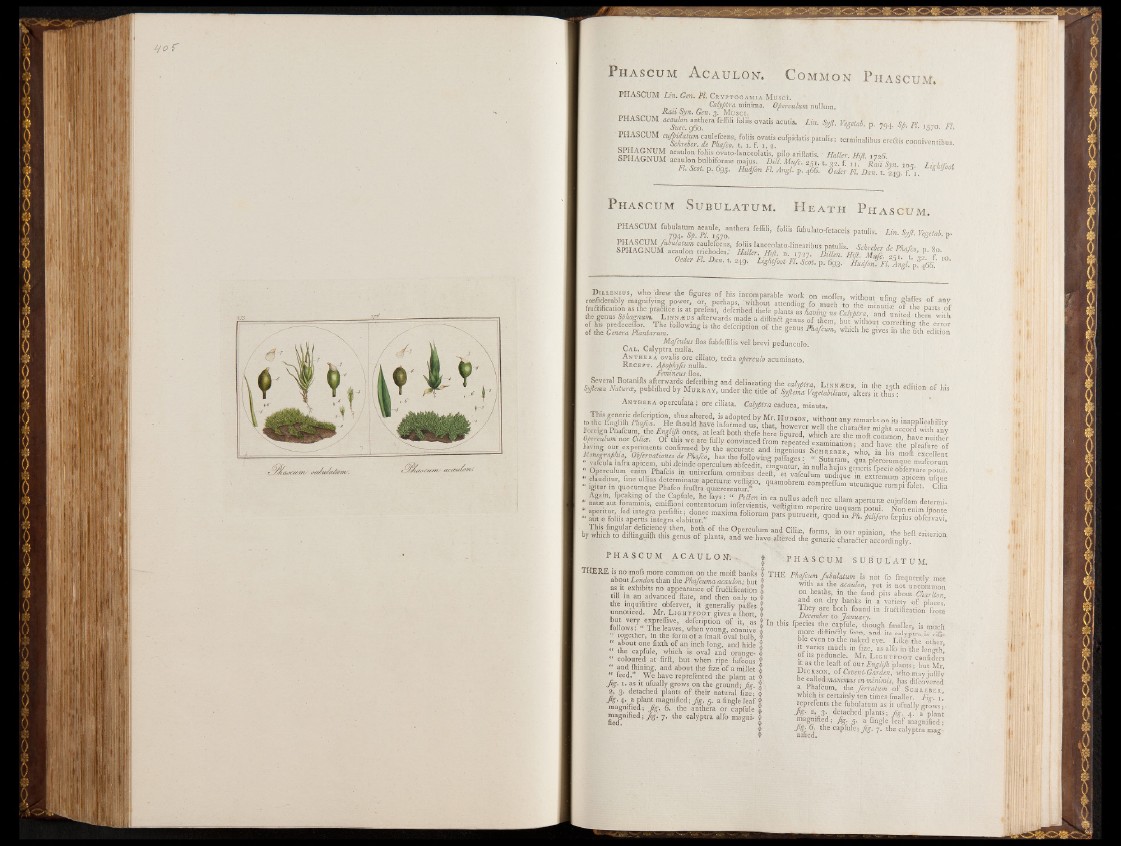
PHASCUM Lin. Gen. PL Cr y p tögAmta Mtfs'cL
h .. | ; Calyptra minima. Operculum nullum.
Kati Syn. Gen. 3. Musci.
•; PHASCUM ac2 i°cn g6ohera feffili fol"S 0Vatis acuti3’ '£in- W - % < " • p. 794- Sp, PL 1570. Ft,
■ PHASCUM OTi t t ! r ^ ' 1 HSf° i : t CUrpid?tiSpatBliS: term’nalibus ereftis conniventibus.
SPHAPNITM aCaUi°n ariftatis. • Haller. Hijl. 1126.
orHAGNUM acaulon bulbifbrme majus. DtU. Mu/c. t. 32 f , , t» v t * r ■ , , , ,
H, & * p , 6 95. 466.
P hascum Su b u l a t um . H e a th P h a s cum .
PHASCUM fubulatum -au le^ an th e ra feffili, foliis fubulato-feUceis patuli, Lin. Syjl. V'g'tal. p.
Ocier FI. Dm. t. 249, S . Serf. p. 693. FI. Angl. p?466. ‘
Dillenius, who drew the figures o f his incomparable work on moffp? withon* „ r i /r r
confiderably magnifying power, or, perhaps without attending To u i ,thout. u^ng glafies o f any
Mqfculus flos fubfeflilis vel brevi pedunculo.
Cal. Calyptra nulla.
A n the ra ovalis ore ciliato, te£la operculo acuminato
R ecept. Apophyfis nulla.
Femineus flos.
SyflamNaturx, i £ É f “ *
A nthera operculata: ore ciliata. Cdyptra caduca, minuta,
having our experiments confirmed by the accuraS a n d ™ 1 h" the P leafure o f
Monograph™, Obferoatimcs de PhnfJo, has the following paffages ■ 1 Suturam an a * , I f f exrcdlent
valfula nfraapicem, ubi deinde operculum abfcédit, I n C t u r in mufrorum
Operculum emm Phafcis in univerfum omnibus deeft 8 et vafrnlnm „ „ A ? ■nens 'PC0Ie Pbfervare potui,
“ clauditur, fine ullius determinate aperturge veftiuio nuamnhrem rr 11 in extremum apicem ufque
• igitur in quocumque Phafco fruftra qu “ rerentur5 ’ qUam°brem ComPreffum ™mp, folet. C.lia
Again, fpeakmg of the Capfule, he fays: g PtSen in ea nullus adeft nec ullam aperturte cuiufdam determ!
natae aut forammis, emiffiom contentorum infervientis, vefligium renerire unuuamïw n f ?T ™ ueteimi-
- iBSifSsssgSö “ ■ ?«Phipiiifcr, ï;r:ö r;
P H A S C U M S U B U L A T U M .
THE Phafcum Jiibulatum is not fo frequently met
with as the acaulon, yet is not uncommon
on heaths, in the fand pits about Charlton '
and on dry banks in a variety of places!
They are both found in fruftification from
December to January.
In this fpecies the capfule, though fmaller, is much
more diftin&ly feen, and its calyptra. is vifi-
. ,bIe ev.en to the naked eye. Like the other,
it vanes much in fize, as alfo in the length,
of its peduncle. Mr. L ightfoqt confiders
it as the leaft of our Englijh plants; but Mr.
D ic k s o n , o£ Covent-Garden, who mayjuftly
be called.77fcmOTtt.5- in minimis, has difcovered
a Phafcum, the /erratum o f Schreber,
which is Certainly ten times fmaller. Fig. 1!
reprefents the fubulatum as it ufually grows; •
fig- 2> 3* .detached plants-; fig. 4. a plant
magnified; fig. 5. a fingle leaf magnified;
d ifl the caPfule; fig- 7- the calyptra mag-
P H A S C U M A C A U L O N 1; > f
THERE is no mofs more common on the moift banks !
about London than the Phafcuma acaulon; but f
as it exhibits no appearance o f fru&ification f
till in an advanced ftate, and then only to f
the inquifitive obferver, it generally pafles |
unnoticed. Mr. L ightfoot gives a fliort, |
but very expreflive, defcription of it, as f
follows: “ The leaves, when young, connive t
I together, in the form o f a fmall oval buib, f
'* about one fixth of an inch long, and hide |
“ the capfule, which is oval and orange- I
A " coloured at firft, but when ripe fufcous |
w and fhining, and about the fize of a millet |
• | | feed.” j We have reptefented the plant at 0
fig. 1. as it ufually grows on the ground; Jig. |
2, 3, detached plants o f their natural fize; f
fig. 4. a pla,nt magnified; Jig. 5. a fingle leaf f
magnified; jig. 6. the anthera or capfule II
magnified; Jig. 7. the calyptra alfo magni- J
ned. * #
¥